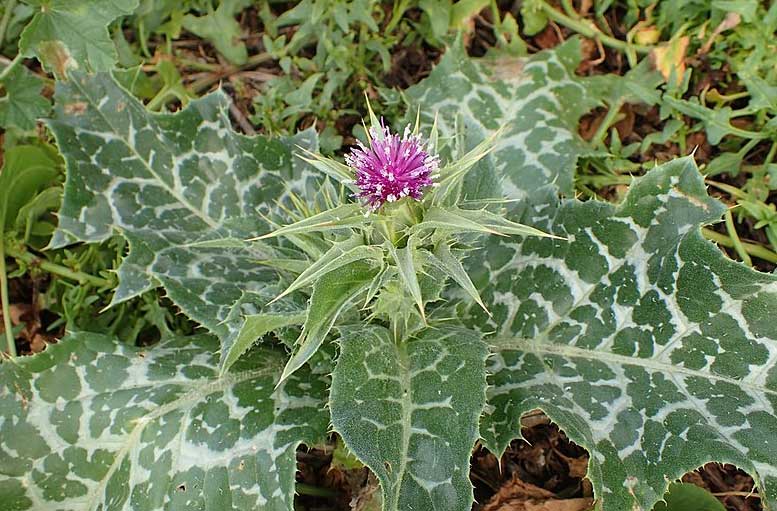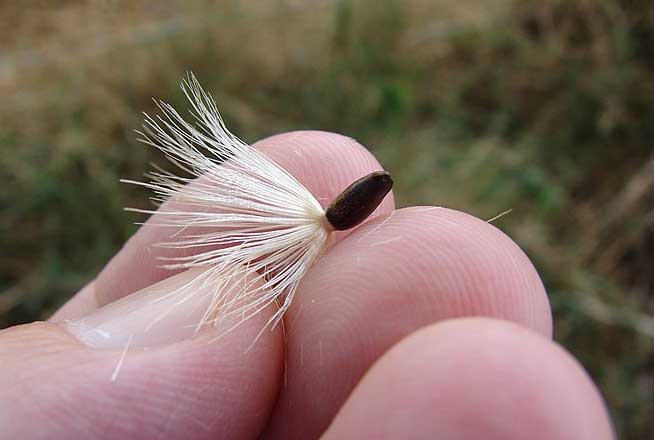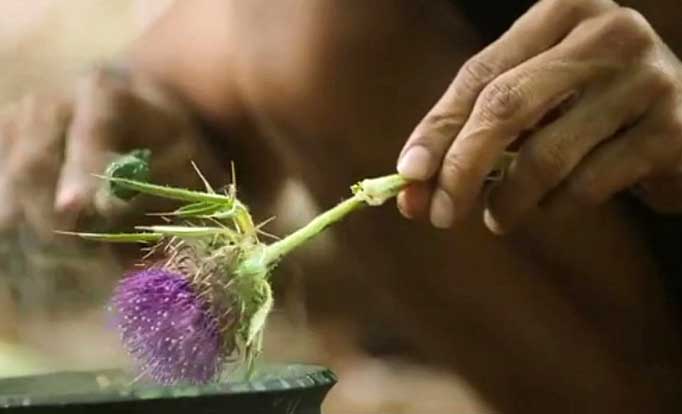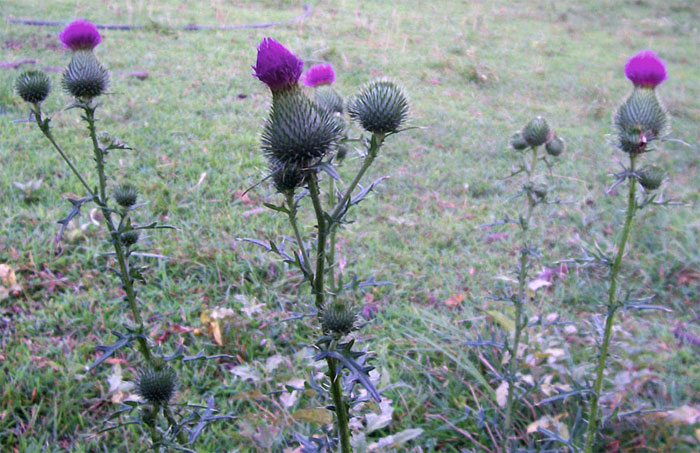Milk thistle in herbal medicine
Milk thistle seeds are strong antioxidants.
Milk thistle (Silybum marianum) seeds have antioxidant properties that are many times stronger than vitamin E. These antioxidants encourage liver cell renewal and help repair damage from degenerative conditions related to alcoholism.

Milk thistle seed can help heal liver damage caused by heavy drinking. If you drink over one or two alcoholic beverages a day, see herbs that help overcome addiction.
This very useful herb is known to contain silymarin, a biochemical believed to heal the liver in just 8 to 16 weeks. Take one or two teaspoons of the ground seeds three or four times a day for best results. After 8 or 10 weeks, reduce amount to ½ teaspoon three times a day.
The ground seeds may also be made into tea, but potency is reduced.

Take milk thistle seed to cleanse the liver.
During a liver cleanse, consider taking milk thistle seed, royal jelly, vitamin C, and potassium supplements. These herbs and supplements stimulate production of new liver cells to replace old damaged ones.
Using milk thistle seeds in herbal medicine and home remedies
Use milk thistle seeds in the treatment of liver disease. Milk thistle seeds, when taken on a regular basis, are known to protect the liver and help it heal.
The little black seeds are often used in the treatment of even severe liver problems like cirrhosis and hepatitis.
Milk thistle seeds can help heal damage done to the liver by toxic chemicals and heavy metals.
They are also used in the treatment of gallstones, psoriasis, acne, high cholesterol, kidney problems, spleen malfunction, and mushroom poisoning.
Use milk thistle seeds to relieve constipation.
Milk thistle seeds make a gentle and effective laxative for constipation. By increasing bile secretions in the intestinal tract, the bowels are lubricated and the stools are softened.
Regular use of milk thistle seeds can actually balance individuals that tend to alternate between diarrhea and constipation.
When diarrhea is present, combine milk thistle seeds with dandelion root for best results.

Beautiful skin with milk thistle seeds
By improving liver function, milk thistle seeds help clear up the skin. When the liver is working properly, the blood is cleansed, and the complexion takes on a healthy glow.
Being a demulcent, milk thistle seeds can soften the skin and help heal acne, skin problems like eczema, redness and dry, cracking lips from the inside out.
Milk thistle seeds can help heal the bladder.
Milk thistle seeds can soothe and moisten the mucus membranes. Regular use can help speed the healing of kidney infections, bladder irritations, and other inflammations.
Milk thistle has a long history.
Milk thistle has been used medicinally (and as a vegetable) for over 2000 years. It goes by many names including Mary's thistle, holy thistle, royal thistle, and prickly thistle.

Science and milk thistle
People have used milk thistle for hundreds of years to treat fatty liver disease, hepatitis, cirrhosis, and other liver problems.
Milk thistle contains silymarin, a powerful flavonoid that regulates cytokines responsible for inducing inflammation.
Milk thistle inhibits free radical formation and protect cells from damage.
There have been thousands of papers published on milk thistle and its healing properties. Research confirms what herbalists have known for centuries!
Milk thistle grows wild in most areas.
Milk thistle is found growing wild on roadsides, along fence lines, and in pastures.
Native to the Mediterranean, the plant now grows wild all over the world and is sometimes considered to be an invasive weed.
The milk thistle plant is easy to spot.
Milk thistle grows up to eight feet tall and usually bears several large pink flowers on branching stems during the summer.
The leaves are wide with white patches or veins. Like all thistles, they have thorns so watch out if you are harvesting them.
The milk thistle plant prefers a dry, sunny location and is easy to grow.
Harvest seed pods in fall. When they are completely dry, remove the seeds to use in home remedies.
Dried leaves and roots, although less potent, may be substituted for milk thistle seeds.
Visit Permaculture Magazine to learn more about using thistles as a food.

*Milk Thistle seeds can cause mild diarrhea by stimulating the release of bile. This effect is most notable with a high-fat diet. Milk thistle might also cause nausea, flatulence, bloating, anorexia, change in bowel habits, headache, rash, insomnia, and impotence, but these reactions are rare. If you experiences these systems, discontinue use.
Always consult with a healthcare professional before using any herbal remedy especially if pregnant, nursing, or taking other medicines.
Sources:
https://www.ncbi.nlm.nih.gov/books/NBK541075/
https://www.ncbi.nlm.nih.gov/books/NBK11896/
Blessings to you and yours!
Thanks so much for reading my blog. Jan.

*Note - the information on this website has not been evaluated by the Food and Drug Administration.
© 2005-2024 website design and content by Janice Boling